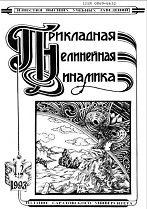|
SCIENCE FOR EDUCATION
Opponing the thesis: Through letters of norm to the principles of objective evaluation
V. M. Anikina, B. N. Poiznerb
a Saratov State University
b Tomsk State University
Abstract:
The authors establish a methodological relationship in the creativity of the competitor of the scientific degree and his opponent, revealing a single context that links: the renewal of the subject of research in the thesis, the provisions put forward for defense, the principles of their examination and assessment of the achievements of the candidate, the essence of formal requirements for revoking the opposition And the possibility of his self-expression as a creative figure involved in the cognitive process. The historical and cultural aspect of the opponing the thesis will be touched upon. The modern opponent (the name of the term is correlated with the ancient Roman triumphs) in practice plays the role of a critic who evaluates both negative and positive qualities of the dissertation, and the purpose of his work is to make a «binary» verdict on the scientific and qualifying quality of the dissertation. It is noted that the essence of the actions of the defending and the opponent can be characterized by the ancient concept of $\rm \acute{\varepsilon}\pi\acute{\iota}\delta\varepsilon\iota\xi\iota\varsigma$ (epideixis). The main requirements for an official opponent are competence and objectivity. In the opinion of the authors, such basic principles, realized in the critical analysis of the dissertation, serve as the manifestation of objectivity: adherence to the ideals of scientific character, the characterization of the improvement in the subject of research conducted in the discourse, the qualification of the protected scientific position in the context of the emergence of new knowledge. The lack of using scientometric indicators of the author or some of his publications to form a value evaluation of scientific work is illustrated. The correctness of the formulations of the aspect characteristics of the dissertation is demonstrated by the example of analysis by opponents of the master’s and doctoral theses by A.N. Schvarz, the Minister of Public Education of Russia in 1908–1910, that the continuity of the evaluation criteria for dissertations is indicated.
Keywords:
Opponent, thesis, subject of research, scientific statement, defense-related, objectivity of expertise, proponent, A.N. Schwarz.
Received: 22.06.2017
Citation:
V. M. Anikin, B. N. Poizner, “Opponing the thesis: Through letters of norm to the principles of objective evaluation”, Izvestiya VUZ. Applied Nonlinear Dynamics, 25:6 (2017), 79–98
Linking options:
https://www.mathnet.ru/eng/ivp48 https://www.mathnet.ru/eng/ivp/v25/i6/p79
|

| Statistics & downloads: |
| Abstract page: | 207 | | Full-text PDF : | 562 |
|




 Contact us:
Contact us: Terms of Use
Terms of Use
 Registration to the website
Registration to the website Logotypes
Logotypes








 Citation in format
Citation in format 